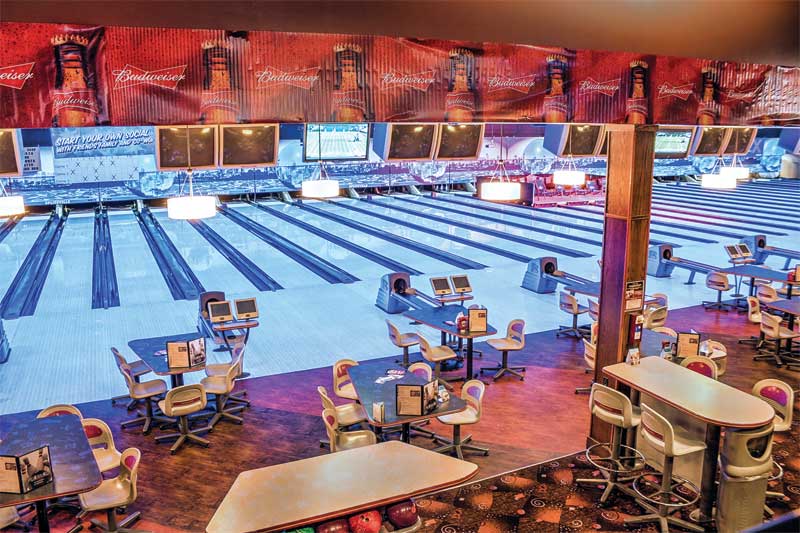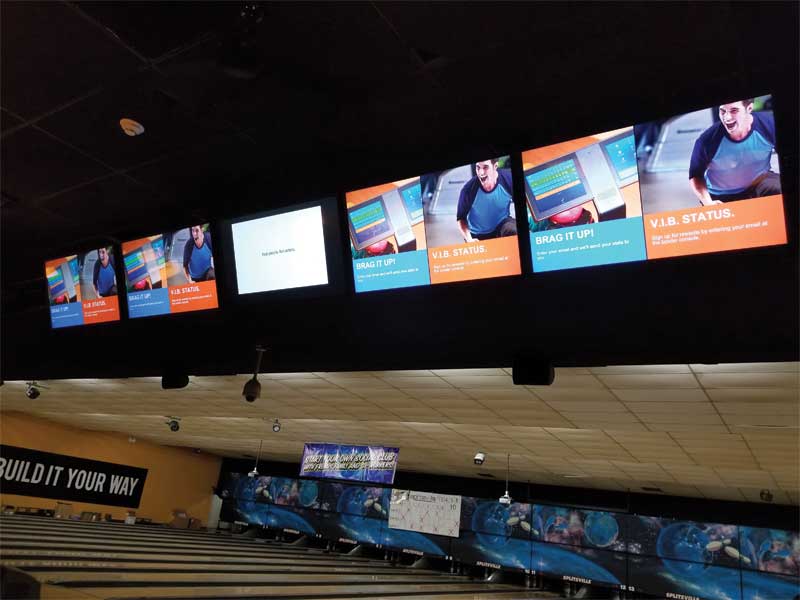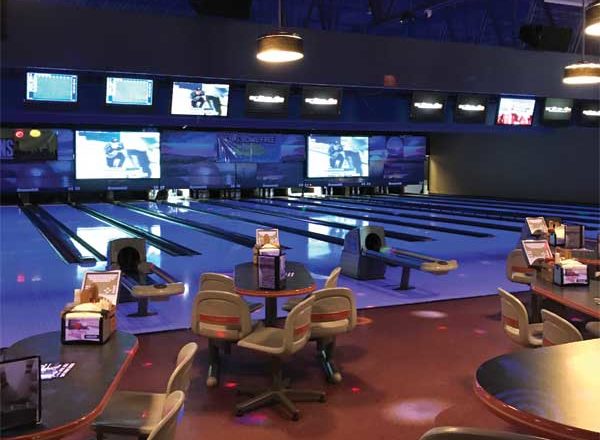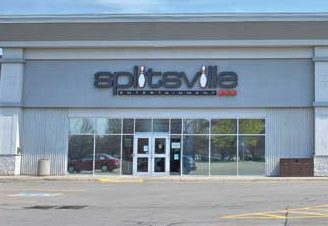Digital Signage: Case study on Splitsville Entertainment
by all | 27 July 2017 10:34 am
 [1]
[1]Photos courtesy Splitsville Entertainment
By Deidre Deacon
As part of its ongoing efforts to revitalize bowling alleys as a viable business in Canada, Splitsville Entertainment has blanketed its facilities—which include locations in Hamilton, Burlington and Woodbridge, Ont., and Nanaimo, B.C.—with visual stimuli by installing digital signage, including drop-down displays, digital projectors and video walls.
The rise of digital signage
From retail stores, automotive dealerships, restaurants and entertainment venues to schools, hotels, corporate office buildings and even funeral homes, the power of digital signage to make a difference in how people experience a place has grown exponentially in recent years. Large and small businesses alike are investing in dynamic display technologies to help them increase collaboration and engagement, by enabling multiple users to create, edit, transform and highlight on-screen images and text in real time. With the right combination of hardware and software, they can market goods, generate advertising revenue, support interactivity and appeal to younger generations with experiential offerings.
There are multiple technical and economic factors driving the current wave of digital signage adoption, including higher screen resolutions, lower prices, improved integration capabilities and other advances in large-format display technology. According to PMA Research, an industry analysis firm that specializes in market data for the digital display industry, the market for interactive flat-panel displays (FPDs) grew by 60 per cent in 2016 and is expected to experience unit growth of up to 50 per cent this year. Market growth for large-format digital displays reached 23 per cent in 2016 and is forecast to remain in the double digits in 2017.
 [2]
[2]The digital signage showcases a mix of promotions, personalized celebratory notices, event reminders, music, advertising, acknowledgements and business presentations.
Beyond the economic and technical advantages of digital signage over other communications media, one driving factor for many business owners is the quest to capture the attention of so-called millennials, who will soon represent the largest consumer demographic. A 2016 retail sector study by Accenture, a global management consulting and professional services company, showed how this generation is eager to use digital forms of communications in experiential ways throughout its travels.
The digital signage industry has responded with screen technologies that fulfil this role and provide instant gratification, from self-serve menu boards at fast-food restaurants and kiosks in airports and shopping malls to wayfinding maps on large campuses andon-site ‘virtual receptionist’ touch screens to games played with video walls in entertainment centres.
From old-school to new-tech
This trend of tapping into the millennial mindset has been exactly the thinking behind Splitsville’s major digital signage deployment, as the company seeks to find new success in an ‘old-school’ business by overcoming the public’s concept of bowling alleys as mere throwbacks to the past.
“Our industry has been around for more than 150 years,” says Pat Haggerty, Splitsville’s president. “It carries with it the baggage of smelly shoes, unpleasant sounds and ugly orange shirts.”
From the 1960s through the ’80s, Haggerty explains, some 75 to 85 per cent of bowling alley revenues came from leagues, with the rest contributed by birthday parties, corporate teams and open playing. A transition in the ’80s toward in-home entertainment changed all of that.
“Once this entertainment technology came on the scene, the leagues shrank to one-tenth of their original size,” says Haggerty.
 [3]
[3]Each on-site installation cost more than $1 million.
This development, once a major problem for bowling alleys, is now seen as a way to save them. Splitsville was founded in 2006 with a vision to shatter negative perceptions of bowling with major renovations that would bring the latest and greatest display technology to the game. The result today is a state-of-the-art audiovisual (AV) experience that appeals to a generation once considered lost to the bowling industry.
“In the past, bowling was, for many, a sport,” says Haggerty. “Now it is considered entertainment first.”
With the significant generational shift from baby boomers to millennials, who are expected to represent 75 per cent of the labour workforce by 2025, it has been important for Splitsville to consider the changing demographics that will drive future interest in its bowling alleys.
“Millennials are much more tech-savvy,” says Haggerty. “We knew that with this shift, bowling would have to do something completely different to survive. It’s been a wakeup call.”
Haggerty and his team were inspired to create an experience “like The Keg’s restaurants,” which serve not just food and beverages, but also an AV extravaganza. The idea was to have digital signage permeate every aspect of a bowling venue, from the lounge areas to the lanes, showcasing a rolling visual smorgasbord of promotions, personalized celebratory notices, event reminders, music, advertising, acknowledgments and, on certain occasions, business presentations.
“I’ve heard the human attention span is now 60 per cent less than it used to be,” says Haggerty, “so people need stimuli that reach a whole bunch of their different senses. We had to move forward with that method of communicating with our audience.”
 [4]
[4]Splitsville Entertainment has opened several locations in Ontario and British Columbia.
Planning placements
The plan was relatively simple in its concept. First, the bowling lanes—which number between 16 and 34, depending on the location—would be divided roughly into zones of six, with each zone featuring a drop-down 3 x 3.7-m (10 x 12-ft) display programmed to play its own music and on-screen content. As such, these screens could be managed independently from each other; and when not in use, they could be raised behind a masking unit by staff using a remote-control central switch at the front desk.
The walls behind the screens would also provide their own entertainment value. Splitsville suspended light-emitting diode (LED) digital projector systems to showcase its own branding, create a ‘wallpaper’ effect or present multiple image panes and messaging configured to suit the specific audience and time of day. Similar projectors were also installed in the party rooms, all of which were connected to the main system, with access to a satellite-based communications network via High-Definition Multimedia Interface (HDMI) cable or cellular port.
Projection systems are often an appealing alternative or complementary resource for digital signage networks, as they cost considerably less than large-format and interactive monitors spanning the same image size. The latest laser hybrid models can generate a 2.5-m (100-in.) ‘screen’ from a distance of just 0.6 m (24 in.) and up to 20,000 hours of lamp life, compared to the 5,000 to 8,000 hours of conventional systems. Some also feature an embedded browser to simplify the delivery of digital signage content.
 [5]
[5]Projectors create a ‘digital wallpaper’ effect on the rear walls.
All of the bars at Splitsville’s locations feature their own banks of large monitors to communicate with customers. The lounge areas feature arrays of 0.8 to 1-m (32 to 43-in.) screens, numbering anywhere from 11 to 14, depending on the size of the location. These video walls are similar to those that have rapidly become a mainstay of airports, office lobbies, car dealerships, hotels, call centres (for displaying performance dashboards) and other venues.
Up to three satellite dishes per Splitsville location deliver the customized AV content to the various displays. The screens are also connected to the Bowling Music Network, which runs commercials every 15 minutes. This frequency can be adjusted according to a location’s needs and audience.
At the Hamilton facility, newer display synchronization technology has been deployed that allows for an increased selection of screen-splitting options, based on 16 to 20 inputs that can be loaded from the head office in Oakville.
“We can dictate what we want to feed into those panes at any time,” says Haggerty. “There is some additional integration we need to do. Once that’s done, we will be moving that technology into our other locations, too.”
Commercial-grade components
Each of the on-site installations cost more than $1 million. Haggerty explains one of the key factors determining the scale of this investment was selecting commercial-grade digital display technologies to ensure high image quality and longer useful life. While pricing differential with consumer-grade screens has narrowed considerably, there are still nuances to higher-grade displays that are appealing in the commercial marketplace, such as much thinner bezels—in some cases less than 2 mm (0.08 in.)—for creating large, seamless video walls.
Beyond the hardware, the quality of the on-screen content is also crucial in capturing the audience’s attention and interest. The aforementioned Accenture study found millennials are particularly influenced by rich video and graphics and engaged by multimedia and multichannel communications, which have all become more easily achieved with advanced software that minimizes the cost and complexity of integrating multiple assets.
“It’s part of today’s reality,” Haggerty says. “Ads are not enough on their own. If you’re selling a hot dog, for example, a static picture of a regular one might seem fine, but if you instead present a richer, moving image of a foot-long with all the trimmings, you can do more to appeal to your customers’ instant gratification needs.”
A journey of many steps
Among the next steps for Splitsville will be adding interactivity with the installation of new digital-display scoring systems. Customers will be able to e-mail their scores, sign up for promotions, collect points, reserve lanes and input other data.
Splitsville’s digital signage journey is a telling testament to the power of visual experiences for today’s consumers. When a digital signage experience is excellent, millennials and other consumers will follow it, whether it relates to retailers clamouring for attention in a shopping mall or to an activity like bowling that has often been considered an outdated tradition. Indeed, now that dynamc display technology has become more affordable and easier to install and manage, businesses of any size in any market can step up their digital signage game to better capture their audience’s attention.
Deidre Deacon is general manager (GM) of ViewSonic Canada, a provider of liquid crystal displays (LCDs), plasma displays, digital projectors and other visual technologies. For more information, visit viewsonic.com[6].
- [Image]: https://www.signmedia.ca/wp-content/uploads/2017/07/Splitsville-image-for-ViewSonic-article-0912.jpg
- [Image]: https://www.signmedia.ca/wp-content/uploads/2017/07/Splitsville-image-for-ViewSonic-article-162822.jpg
- [Image]: https://www.signmedia.ca/wp-content/uploads/2017/07/3-digital-signage-e1500997868809.jpg
- [Image]: https://www.signmedia.ca/wp-content/uploads/2017/07/Splitsville-image-for-ViewSonic-article-X1-HDR-e1500997998528.jpg
- [Image]: https://www.signmedia.ca/wp-content/uploads/2017/07/Image-from-Splitsville-re-ViewSonic-article.jpg
- viewsonic.com: http://viewsonic.com
Source URL: https://www.signmedia.ca/digital-signage-case-study-on-splitsville-entertainment/